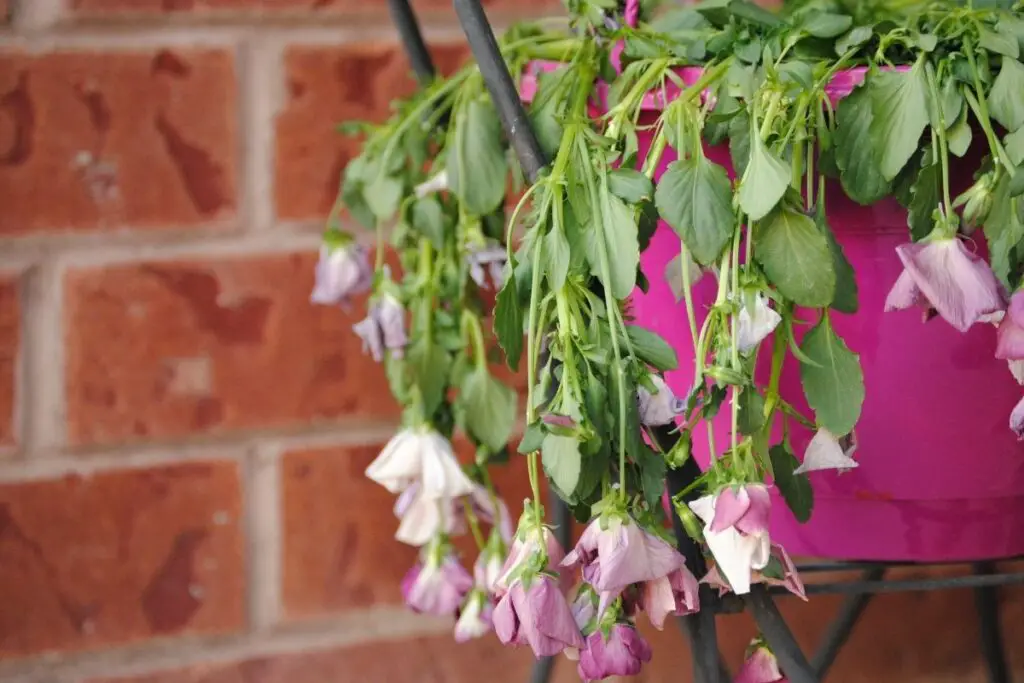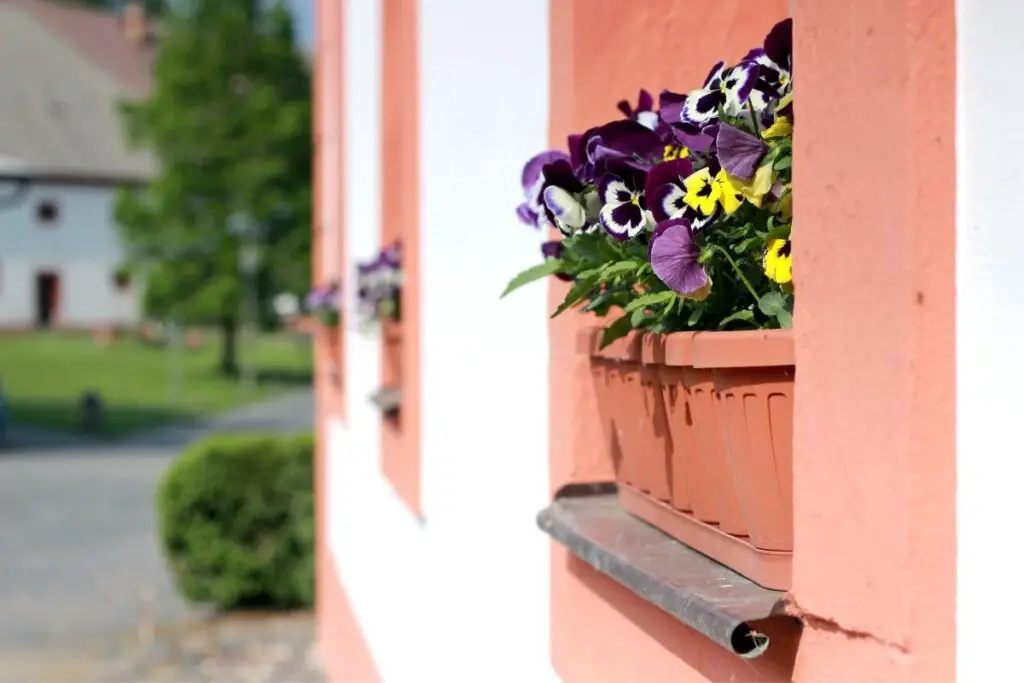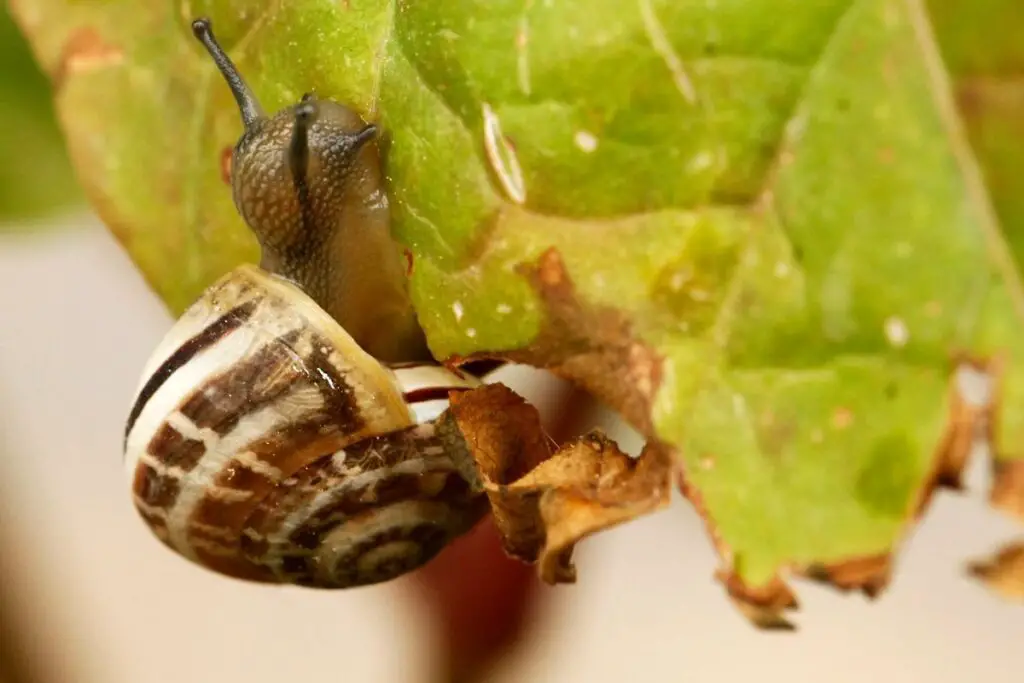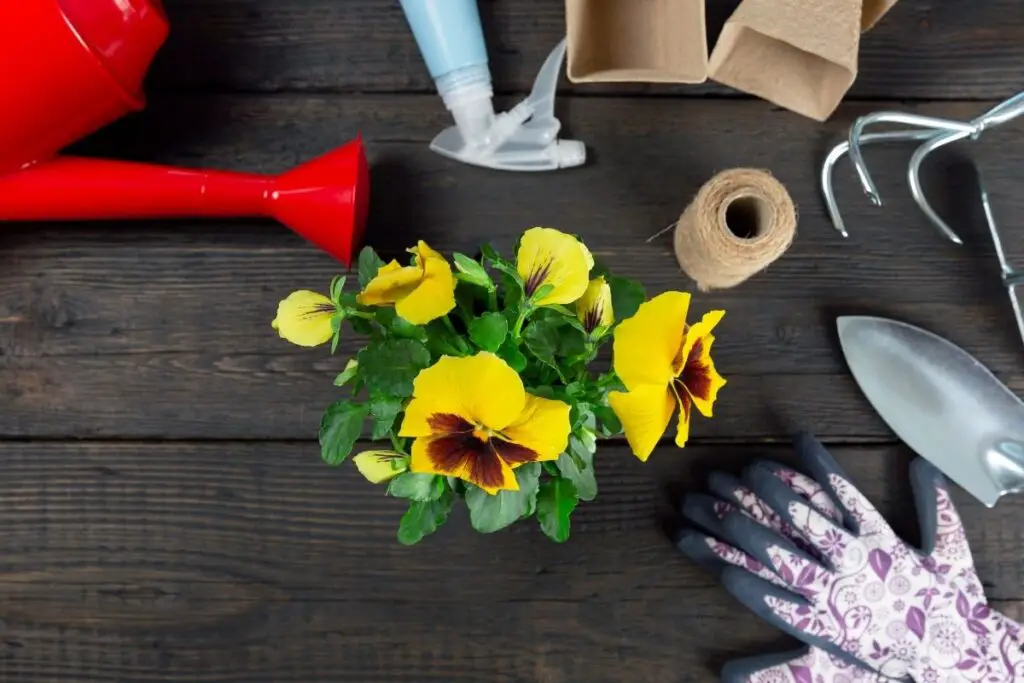A pansy is a small and bright-colored flowering plant with large round petals. They grow best in cool weather and are usually planted in the spring or fall months.
But sometimes despite doing everything correctly, our pansies start drooping. So, in this article, we shall discuss why is my pansy drooping.
The primary causes of droopy pansies are too much heat, root rot, nutrient deficiencies, and improper watering technique. Pansies prefer rich, well-drained soil high in organic matter and require ample sunlight and appropriate watering. Inappropriate care behavior can make your pansy droopy.
In this article, let’s find out why the leaves of your pansies are drooping and how we can fix it.

Common causes for drooping pansies
Here are some common reasons for drooping pansies:
- Watering problems
- Extreme temperatures
- Improper sunlight
- Poor air circulation
- Fungal disease
- Pest and insects
- Nutrient deficiencies
- Poor drainage system
Lets us now discuss each point in detail.
Watering problems
Pansies can droop because of water stress. Pansies need a minimum of 1 inch of water weekly when they are actively growing.
They can react negatively to a lack of water or too much of it. Both overwatering and under-watering can cause droopy leaves of your pansies.
Overwatering can cause edema in pansies (abnormal water retention in plants).
Pansies need consistent moisture, and they prefer well-draining soil since their roots won’t withstand soggy soil. Overwatering can lead to root rot issues and prevent oxygen from reaching them.
Similarly, under-watering will cause inadequate hydration in pansies.
Since these plants grow primarily during cooler seasons, the soil may dry quickly and require frequent watering. Underwatering can cause the soil to dry quickly, encouraging droopy leaves.
Solution
In case of overwatering:
- Check the soil immediately. If the soil seems dark and moist, avoid watering.
- You should provide all means for proper drainage.
- Move your pansies to a sunny spot so that the soggy soil can dry out fast.
- You have to create additional space between the roots. For that, you should remove dead or dying roots and keep only the healthy roots.
In case of under-watering:
- Change your watering schedule by shortening the length of time between waterings.
- Check the moisture level of soil and water your plant only if the topsoil feels dry.
Also read: How Much Water Does A Pansy Need? (Pansy Water Requirements)
Extreme temperatures
Pansies are cold-weather flowers that do best during the spring and fall months. Pansies grow best when the temperatures are between 45-65°F.
Pansies can even tolerate little freeze during winters, but they cannot bear temperatures below 25°F. Pansies become weak and vulnerable, and they start dropping their leaves, and the flowers and foliage will start wilting.
Pansies cannot tolerate excessive heat either. Temperature above 65°F is hard on them. They frequently go dormant during hot weather. High temperatures can cause the leaves of your pansies to droop.
High humidity on a summer day can reduce the quantity of water needed by the leaves. This will again cause droopy leaves of pansies.
Solution
In case of extreme heat:
- Start early morning watering of your pansies during harsh summers. This will prevent heat stress and ensure that roots are well hydrated before the oppressive heat of the day begins.
- Make arrangements for providing your pansies with partial shade. You can do that by putting a shade of cloth over them.
- You can also transplant them under cover of taller plants with an established root system.
- Mulch on the ground around your pansies to retain soil moisture.
In case of extreme cold:
- Don’t overwater during winters because moisture is retained for long during this season. Overwatering will make the soil soggy and will cause root rot.
- You can construct a cold frame or greenhouse to save your pansies from extreme temperatures.
- You can install a heat source by combining it with a covering or cold frame.
Also read:
Looking for gardening supplies? We have tested 100's of products before recommending them to you guys. Check out our best pick below:
| Image | Gardening Supplies | Best Price? |
|---|---|---|
 Top
Top Top
Top | Raised Garden Bed Kit | Check On Amazon |
 | XLUX Soil Moisture Meter, Plant Water Monitor, Soil Hygrometer Sensor for Gardening, Farming, Indoor and Outdoor Plants, No Batteries Required | No Results |
 Top
Top Top
Top | 82 Pcs Garden Tools Set and Extra Succulent Tools Set | Check On Amazon |
 | Joeys Garden Expandable Garden Hose with 8 Function Hose Nozzle, Lightweight Anti-Kink Flexible Garden Hoses, Extra Strength Fabric with Double Latex Core, (50 FT, Black) | No Results |
 Top
Top Top
Top | Dual Chamber Compost Tumbler | Check On Amazon |
 Top
Top Top
Top | Sunnyglade Plant Stakes | Check On Amazon |
 Top
Top Top
Top | Organic Cold Pressed Neem Seed Oil | Check On Amazon |
 Top
Top Top
Top | Mighty Mint Gallon :-Insect and Pest Control Peppermint Oil | Check On Amazon |
 Top
Top Top
Top | Scotts DiseaseEx Lawn Fungicide | Check On Amazon |
 Top
Top Top
Top | Jacks Classic 20-20-20 All Purpose Fertilizer | Check On Amazon |
 Top
Top Top
Top | 30,000 Seeds Pollinator Attracting Wildflower Mixture | Check On Amazon |
 Top
Top Top
Top | Survival Vegetable Seeds Garden Kit-Over 16,000 Seeds | Check On Amazon |
Improper sunlight

Pansies prefer full to partial sunlight. They enjoy the morning sun and require at least six hours of proper sunlight for their growth.
Lack of sufficient light can be a cause of droopy leaves for them. Lack of proper light will slow down the photosynthesis process in pansies.
The leaves of your pansies will start getting lighter in color, and the leaves will turn yellow and droopy.
Lack of light can stunt the growth of the pansies. Pansies will not be able to make their food with poor light. Also, this will increase the space between their leaves, and the leaves will become thin and droopy.
Insufficient light can also cause root rot issues in pansies. Also, extreme heat will hamper their growth. So an adequate amount of sunlight is essential for your pansies growth and health.
Solution
- Place your pansies in full sun for at least 4 to 6 hours. This will help them to fulfill their moisture requirement.
- Pansies always prefer an afternoon shade. Since they don’t like too much heat and this can also prevent sunburn.
Also read: How Much Sun Do Pansies Need? (Pansies Light Requirements)
Poor air circulation
Ensuring airflow around your pansies is as vital as sunshine, water, and organic matter.
Pansies are garden plants that do not like overcrowding. Pansies must get six to ten inches of space between them. Without room to breathe, your pansies can get overcrowded as they grow.
Poor air circulation encourages fungal growth in the pansies and this can also be a reason behind the droopy leaves.
If you don’t want to see your pansies grow thin and sickly, you must maintain a moderate gap between planting them so that they don’t experience poor air circulation.
If you don’t do this, your pansies will grow leggy and their leaves will droop.
Overcrowding can cause fungal diseases like downy mildew. This fungus makes your pansy flowers look worse. The fungal infection will stunt growth, weaken the stems and cause drooping.
Solution
- You must give gaps in between each pansy plant. You can maintain a gap of around 6-10 inches.
- If your pansies have become leggy, you hmust prune the leggy part and let the remaining part grow healthy again.
- Make sure your garden has ample sun exposure, especially in the morning. Sunlight must reach every plant in your garden.
- It would help deadheaded pansies to give space for the new flowers to arrive during the growing season.
Diseases in pansies
Pansies can also have droopy leaves because of a fungus attack. Pansies that grow in poor quality soil will sit in the water for too long and might develop root rot.
Pansies’ most common problems are fungal diseases such as powdery mildew, leaf spot, and Botrytis blight. These diseases will cause your pansies’ roots to rot and make the plant weak and droopy.
Solution
- You should plant your pansies in areas that support proper drainage and avoid sites where water tends to collect after rain or irrigation.
- Water your pansies in the morning so that the moisture evaporates and doesn’t make the pansies overwatered.
- If a fungal disease has already attacked the plant, you should cut the affected parts of your pansies to save it.
- Treat your pansies with a fungicide solution that contains mefenoxam. Fungicide won’t cure the disease but can prevent it from spreading.
Pest and insects

Pests will attack your pansies if they are in a weak condition. Pests absorb all the nutrients from your pansies and make the plants weaker. The leaves fail to hold themselves and start to droop.
Your pansies can get attacked by thrips, spider mites, aphids, snails, etc. They attack your pansies in warm and humid conditions. Snail or slugs come at night and eat away the leaves, causing plant damage and stress.
Solution
- Spray water to your pansies’ leaves due to which these insects will start falling into the soil.
- Wash your pansies with a non-detergent soap mixture.
- Depending on the pest you are dealing with, you can use neem oil, horticultural oil, or diatomaceous earth.
- You can also use chemical pesticides but follow the instructions in the label before use.
Also read: How To Get Rid Of Pests On Pansies? (Bugs Identification+Solution)
Nutrient deficiencies
Nutrients in the soil can create a significant impact on pansies. If pansies don’t get sufficient nutrients from the soil, they will become weak, and the lower leaves of pansies will turn yellow and become droopy.
Nitrogen is the most important nutrient that pansies need. Nitrogen deficiencies stunt the growth of pansies. You can address this issue with some nitrogen-rich fertilizers.
Fertilizer will enrich the soil with essential nutrients such as nitrogen, phosphate, and potash.
Solution
- Consider adding compost while preparing the soil for the pansies.
- Or add a well-balanced fertilizer with an NPK ratio of 10:10:10. Fertilize every month so that the pansies do not run out of nutrients.
- You can opt for a high phosphorus fertilizer with an NPK ratio of 5:10:5 after the pansies start blooming.
Also read: Do Pansies Need Fertilizer? (What Type, How Much & More)
Poor drainage system
If your pansies are growing in the wrong soil that doesn’t support good drainage, they can develop root rot which will cause droopy leaves. Lack of drainage can cause the roots to sit in standing water.
Pansies prefer well-draining soil, which has a pH value between 5 to 6 on the pH scale. The soil must be slightly acidic. Pansies need fertile soil that can retain moisture but also drain out the excess.
Also, if the soil contains too much sand or clay, this can cause overwatering or under-watering problems.
Solution
- Check the condition of your garden soil before you plant your pansies.
- Pansies prefer rich loam soil that facilitates drainage and retains sufficient moisture.
- You can spread 2 inches of compost over the soil’s surface and start working on it. Add organic matter to improve soil quality.
Also read: What Type Of Soil Is Best For Growing Pansies? (+Best Soil Mix)
Care tips for pansies

Watering: Water your pansies regularly throughout the growing season. One of the main reasons behind the droopy leaves is that they are not watered enough. Let the soil dry slightly between the watering sessions. The drier soil conditions help pansies harden off and tolerate cold.
Fertilization: You can use general all-purpose fertilizer around your pansies, which will help them to grow. Be aware of heavy nitrogen fertilizers because this can result in more foliage instead of flowers.
Pruning: Always remove faded and dead flowers to encourage the plants to produce more blooms and prolong the blooming season. Timely pruning your pansies is important for their survival.
Protection: Apply organic mulch that retains soil moisture and discourages weeds during the flowering season. You can apply a protective cover of straw during winters that will safeguard roots against rapid temperature fluctuations. This will prepare your pansies buds to burst into blooms.
Final words
Pansies are healthy, low maintenance, and easy to grow plants. You can grow pansies quickly in your garden with some care and effort.
You can easily prevent your pansies from drooping and help them grow by following the steps below.
- Maintain a proper watering schedule for your pansies. Avoid overwatering and under-watering. Both can result in droopy leaves.
- Never over-fertilize your pansies, as that can make the leaves droop. Fertilize the pansies every two to three weeks with liquid fertilizer and apply granular fertilizer every six weeks for encouraging roots and plants growth.
- Plant them in an area that gets sufficient sunlight. Provide your pansies with some afternoon shade.
- Plant them in well-draining soil and always check the moisture level of soil before watering. Add water immediately if the soil feels dry. Dry soil will lower the moisture level in the plant, which will cause droopy leaves.
- Prevent overcrowding of plants. Start spacing your pansies to promote airflow between them. Poor air circulation can lead to root rot and droopy leaves.
- Timely pruning and deadheading pansies are vital for building space for new blooms.
Ref: The University of Arkansas, Britannica, Utah State University, Wikipedia, The University of Georgia, The Pennsylvania State University, The Royal Horticultural Society.
